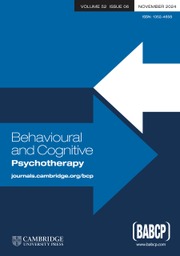Acceptance and Commitment Therapy (ACT; Hayes, Strosahl and Wilson, Reference Hayes, Strosahl and Wilson1999) stands at the forefront of the “third wave” (mindfulness-based) CBTs. The increasing influence of this approach is evident in the range of books that have appeared over the past few years, including practical guides to ACT (Hayes and Strosahl, Reference Hayes and Strosahl2004; Luoma, Hayes and Walser, Reference Luoma, Hayes and Walser2007), self-help books (e.g. Hayes and Smith, Reference Hayes and Smith2005; Robinson and Strosahl, Reference Robinson and Strosahl2008), ACT for anxiety (Eifert and Forsyth, Reference Eifert and Forsyth2005), depression (Zettle, Reference Zettle2007), and trauma (Walser and Westrup, Reference Walser and Westrup2007). The Worry Trap is a useful addition to these volumes; this brief book is an ACT-based self-help guide designed to help people make room for worry and anxiety so that they can build more meaningful and fulfilling lives.
The book begins with an overview of the nature and function of worry and anxiety, along with a brief summary of prominent intervention approaches (e.g. cognitive therapy, exposure, relaxation training, and ACT). Chapter 2 imparts some of the key features of the ACT model of anxiety (and psychopathology more generally), which views internal control attempts as part of the problem rather than the solution. The author does a good job of communicating ACT's focus on altering psychological context (i.e. how one relates to internal states) rather than on modifying or reducing difficult psychological content.
The material in the book is organized around a five-step model (LLAMP), which clearly maps onto ACT's core processes/skills:
Label worry thoughts
Let go of control
Accept and observe thoughts and feelings
Mindfulness of the present moment
Proceed in the right direction
This straightforward organization helps the reader understand the functions of, and the relations between, the various techniques that are introduced. Chapters 3 through to 8 contain a range of ACT metaphors and experiential exercises, and provide examples that will be highly relevant to clients experiencing worry and anxiety. The penultimate chapter seeks to draw together the various skills, and shows how they can be woven into daily living, always guided by the client's deeply held values and goals. The final chapter outlines some other basic skills that can help worriers engage in effective action, including action planning, time management, problem solving, and assertiveness.
This book is likely to be a useful resource for ACT therapists and clients alike. Its strength lies in the use of the simple LLAMP framework, and Lejeune's skill in communicating acceptance-based concepts and strategies. To take one example, he clearly highlights the distinction between “inside willingness” (mindfulness/acceptance) and “outside willingness” (commitment to action). In this way, he is able to illustrate the two broad skill sets that lie at the heart of ACT interventions. The author also includes an impressive array of mindfulness exercises (Chapter 7), which will be useful to any therapist who is using mindfulness with his or her clients.
Throughout the book, Lejeune is meticulous in ensuring that the reader does not use ACT exercises in an attempt to control anxiety or worry. For example, relaxation is introduced not as a method for reducing undesirable affect, but to serve as a reminder to let go of control and to adopt a non-judgemental posture towards one's private events. In sum, the author appears to have thought a great deal about how to translate ACT principles and procedures into a form that can be understood (and, more importantly, experienced) by anxious clients.
The book's shortcomings are fairly minor. The book might have benefited from including visual representations (e.g. cartoons) of key ACT metaphors (such as Passengers on the Bus); although these can be found elsewhere in the ACT literature (see Hayes and Smith, Reference Hayes and Smith2005). It would have been useful to have included a CD containing some of the mindfulness/meditative exercises, rather than rely on clients memorizing the scripts or making their own recordings. However, I still feel that the exercises are presented in a way that will help clients quickly get the gist of mindfulness practice.
There is a growing body of evidence that supports the use of ACT for a range of problems, including worry and anxiety, depression, pain, eating disorders, work-related stress, psychosis, and even epilepsy (see Hayes, Luoma, Bond, Masuda and Lillis, Reference Hayes, Luoma, Bond, Masuda and Lillis2006 for a review). In my view, The Worry Trap, along with other recently published ACT self-help guides, will help to communicate ACT principles to an even wider audience.



Comments
No Comments have been published for this article.